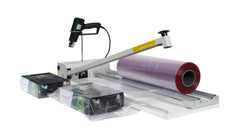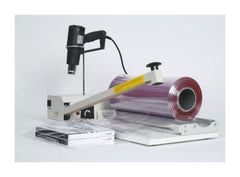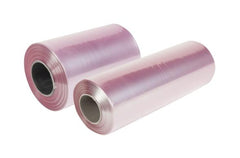Shrink Wrap Sealers
More information about Shrink Wrap Sealers
Our Guide to Heat Sealers and Shrink Wrap Sealers
Discover our extensive range of premium Heat Sealers and Shrink Wrap Sealers, specifically designed to meet the diverse needs of busy packaging areas. Our products are robust, reliable, and designed to enhance efficiency and productivity in your packaging process. Whether you're in the food industry, retail, or manufacturing, our heat sealers will provide the durability and performance you need.
Our Shrink Wrap Sealers are perfect for businesses looking to protect and professionally present their products. These sealers offer high precision and consistency, ensuring your products are always perfectly packaged and ready for distribution. With our Heat Sealers, you can securely seal a wide range of materials, from plastic bags to thick polythene, providing your products with the protection they need.
Explore our collection today and find the perfect Heat Sealer or Shrink Wrap Sealer that suits your business requirements. Experience the difference in quality and efficiency that our products bring to your packaging process.
Understanding the Functionality of Shrink Wrap Sealers
Shrink wrap sealers are an essential tool in packaging, using heat and pressure to create a secure seal around products. This protective layer keeps items free from dust, moisture and contamination. The process involves wrapping products or pallets in plastic, heating it to cause shrinkage and forming a secure hold around the items.
These shrink wrap sealers play a crucial role in quality control, ensuring the wrap is applied evenly and correctly, thus preventing any damage during transit.
Choosing the Right Shrink Wrap Sealer from First Mats
First Mats offer a diverse range of shrink wrap sealers suitable for various needs. From heavy-duty S-type sealers for intensive use to desktop models with a single impulse heat bar for lighter tasks. The range extends to adjustable power gas guns for larger goods and different film types, and a simple, effective electrically powered hot air gun for smaller packages.
All our sealers fit a broad range of film and wrap sizes to accommodate various requirements.
Things to Consider
- Quality and durability: Consider the build quality and materials used in the construction of the heat sealer. Look for a reputable brand known for producing high-quality and long-lasting sealers.
- Sealing capacity: Determine the maximum sealing width and thickness that the heat sealer can handle. Ensure it meets your specific requirements for sealing various types of materials or bags.
- Temperature control: Check if the heat sealer provides adjustable temperature settings. This feature is crucial to ensure proper sealing of different materials without causing damage or compromising seal quality.
- Sealing speed: Evaluate how the heat sealer can seal bags or packages. You may require a fast or slow sealing speed, depending on your needs. Consider the productivity and efficiency of the machine based on the desired sealing speed.
- Safety features: Look for safety features such as an automatic shut-off mechanism or a heat-resistant handle. These features can prevent accidents or injuries during operation and ensure the user's safety.
- Ease of use: Consider the user-friendliness of the heat sealer. Look for features like a clear control panel, intuitive interface, and easy-to-follow instructions. A simple and straightforward operation can save time and reduce the risk of errors.
- Portability and storage: If portability is a requirement, consider the size and weight of the heat sealer. Look for a compact and lightweight model that can be easily transported or stored when not in use.
- Additional features: Evaluate any additional features or accessories that come with the heat sealer. This could include features like a built-in cutter for trimming excess material or a bag holder for convenient sealing. Assess whether these features align with your specific needs and can enhance the overall functionality of the heat sealer.
Frequently Asked Questions
What is a Heat Sealer?
A heat sealer is a device used to seal or close various types of packaging materials using heat. It is commonly used in food packaging, pharmaceuticals, electronics, and manufacturing industries.
The heat sealer applies heat to the packaging material, typically plastic, to melt and fuse it together, creating an airtight and secure seal. This helps preserve the package's contents, prevent leakage, and maintain product freshness.
Depending on the application and packaging requirements, heat sealers come in various sizes and types, including handheld sealers, foot-operated sealers, and automatic sealers.
What Can Heat Sealers be used for?
Heat sealers can be used for various purposes, including:
1. Packaging: Heat sealers are commonly used to seal plastic bags, pouches, and other packaging materials. They create an airtight and tamper-proof seal, ensuring the freshness and safety of the contents.
2. Food preservation: Heat sealers are widely used in the food industry to preserve perishable items. By sealing food in airtight bags or containers, heat sealers help to extend the shelf life and prevent spoilage.
3. Medical and pharmaceutical applications: Heat sealers are used to seal sterile medical supplies, such as surgical instruments, gloves, and dressings. They ensure the integrity and safety of these items, preventing contamination.
4. Industrial packaging: Heat sealers are used in industrial settings to package various products, such as electronics, hardware, textiles, and chemicals. They provide a secure seal that protects the items during storage and transportation.
5. laboratory use: Heat sealers are used in laboratories to seal sample bags or containers, ensuring the containment and integrity of the samples. This is particularly important for sensitive or hazardous materials.
6. DIY projects: Heat sealers can be used for various DIY projects, such as creating custom-sized bags, making waterproof pouches, or sealing artwork or documents for protection.
7. Crafts and hobbies: Heat sealers are used in crafts and hobbies, such as making jewellery, creating custom patches, or sealing shrink wrap around gift baskets or handmade products.
8. Document protection: Heat sealers can be used to laminate documents, protecting them from moisture, dirt, and wear. This is commonly done for ID cards, badges, certificates, or important papers.
Overall, heat sealers are versatile tools that provide a reliable and efficient way to seal and protect various items in different industries and applications.
How do you use a Heat Sealer?
To use a heat sealer, follow these steps:
1. Prepare the heat sealer: Plug in it and let it heat up according to the manufacturer's instructions. Most heat sealers have an indicator light that turns on when it is ready to use.
2. Prepare the packaging material: Place the item you want to seal inside the packaging material, such as a plastic bag or shrink wrap. Ensure the item is positioned properly and there is enough excess material to create a seal.
3. Position the heat sealer: Hold the heat sealer in one hand and position the sealing element (usually a metal or Teflon strip) directly above the area where you want to create the seal.
4. Apply pressure: Press the heat sealer firmly down onto the packaging material, applying even pressure. Hold it in place for a few seconds to allow the heat to transfer and create a seal.
5. Move the heat sealer: Slowly move the heat sealer along the desired sealing line, maintaining constant pressure. This ensures that the entire area is sealed properly.
6. Release pressure: Once you have sealed the desired length, release the pressure on the heat sealer and lift it off the packaging material.
7. Allow the seal to cool: Give the seal a few seconds to cool and solidify before handling the package. This helps to ensure a strong and secure seal.
8. Repeat if necessary: If you need to create multiple seals, repeat the process by positioning the heat sealer at the next desired location and following steps 4-7.
9. Clean and store the heat sealer: After using it, unplug it and allow it to cool completely. Clean the sealing element if necessary, following the manufacturer's instructions, and store it in a safe place for future use.
Note: It is important to read and follow the specific instructions provided by the manufacturer of your heat sealer, as different models may have slight variations in operation.
First Mats Choice
-
 Professional Heat Sealing Machine 800mm
Professional Heat Sealing Machine 800mm

["Max film width 800mm","Portable and efficient","No warm-up time required"]
3 to 5 working days £323.80 Excl. VAT -
 Professional Heat Sealing Machine 450mm
Professional Heat Sealing Machine 450mm

["Max film width 450mm","Portable and efficient","No warm-up time required"]
3 to 5 working days £229.80 Excl. VAT -
 PVC Centrefold Shrink Wrap Film - 19 Micron
PVC Centrefold Shrink Wrap Film - 19 Micron

["600m roll lengths","Great clarity","Widths from 200mm - 500mm"]
3 to 5 working days £53.80 Excl. VAT











